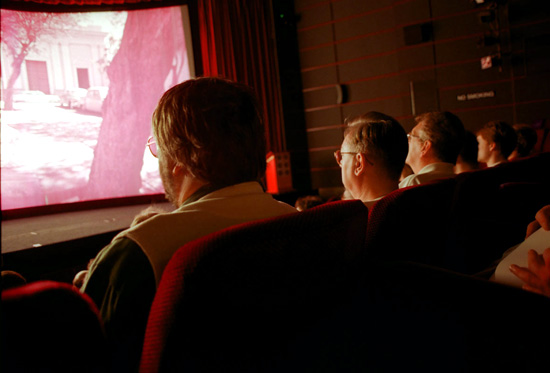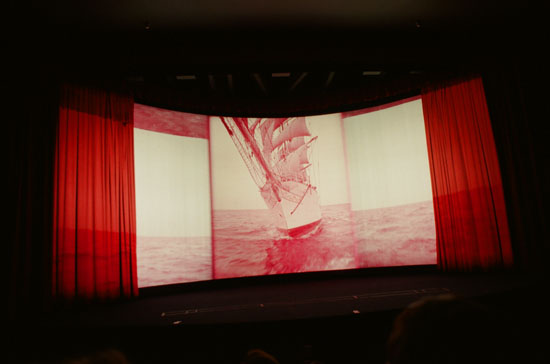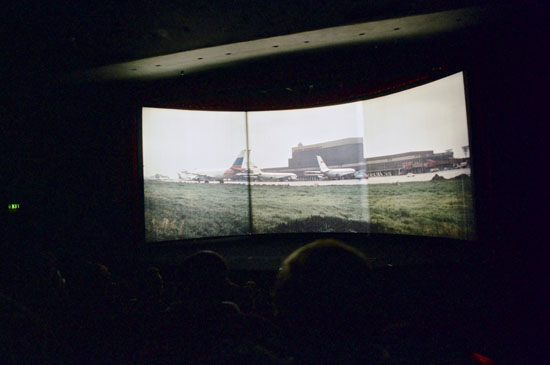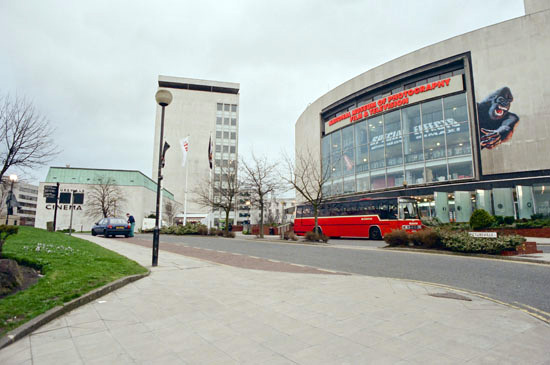Misconceptions about the Bradford setup |
Read more
at in70mm.com The 70mm Newsletter |
| Written by: Bill Lawrence, Head of Cinema, National Museum of Photography, Film and Television, Bradford, England. Pictures by: Thomas Hauerslev | Issue 50 - September 1997 |
 Audience
watching the first 3-strip performance of "Windjammer" in 20+ years. Picture by Thomas Hauerslev Audience
watching the first 3-strip performance of "Windjammer" in 20+ years. Picture by Thomas HauerslevAs usual we eagerly opened the latest issue of The 70mm Association Newsletter and certainly enjoyed the many articles. However, we feel it necessary to correct on/two errors and misconceptions about the Bradford setup. First of all, in the article about “Windjammer” David Page refers to the “center projector isn’t set for 3-strip”. In fact, the center projector is an original Cinerama projector and is only used for three strip presentations. Sadly, I also feel that David’s feelings about the Widescreen Weekend at the Bradford Film Festival are particularly personal and selective. While it is true that there were problems, most out of our control, by far the majority of the weekend was successful, with 70mm/Cinerama screenings of “It’s a Mad, Mad, Mad, Mad World”, “Those Magnificent Men…” (Unscheduled), “This is Cinerama”, “Windjammer”, “Vertigo” and “The Big Blue”. |
More
in 70mm reading: Widescreen Weekend 1997 • Gallery: 1997 • WSW Home • Through the Years • The Best of WSW • Academy of the WSW • Creating the WSW • Planning the WSW • Projecting the WSW • Home of CINERAMA • Projecting CINERAMA Is Windjammer the Queen of Kitsch? Internet link:
|
 Showing
3-strip is not routine even for the skilled projectionists in Pictureville.
Problems are always fixed quickly. Showing
3-strip is not routine even for the skilled projectionists in Pictureville.
Problems are always fixed quickly. We had problems with “My Fair Lady”, because two parts were lost at the print store in London (and still have not been found), “Lawrence of Arabia” was late arriving because the distributor misplaced the print in America, and “How The West Was Won” was shown at David’s insistence despite my feelings that the soundtrack was too worn to complete a full screening in one go – which it barely did. However, the major problem with “HTWWW” was that we had to try and carry out a major re-edit on with a different soundtrack to 1996, as well as inserting the English titles. This is a lengthy time-consuming project at the best of times, in the heat of a film festival it is almost impossible. We did not have sufficient time to allow for a rehearsal and checking. |
|
 The
infamous Kinopanorama footage. The
infamous Kinopanorama footage. Meanwhile, John Steven Lasher's Kinopanorama 2 minute film did not work, because it wasn’t ready to be shown – it didn’t have its soundtrack. We had to lash together old technology with new digital sound to make it work – it was not our choice, it would have been easier not to try. Finally, around the issue of the cut from Lowell Thomas´ introduction to “This is Cinerama” to the roller coaster sequence, the issue is not “something that Bradford has yet to comprehend” but rather a product of both Museum aesthetics and technology. When we set up Cinerama in Bradford we decided to go for as close to the original form as it is to get with current finance and technology. Consequently, we chose to use a louvered screen rather than a modern screen. Further, the prologue was originally produced on standard 35mm 4 sprocket film, whereas Cinerama was produced on 35mm 6 sprocket. So in the original screening the prologue was run by a separate projectionist from a 35mm booth. In later prints, the prologue was combined with the 3-strip Cinerama print as in Dayton. As a result, technically when Lowell Thomas says This is Cinerama the audience has already been watching it for 20 minutes only the two outer panels are blank. |
|
 When the film is shown in Bradford we do not run Cinerama until after the
prologue. With this change of projector it takes some seconds to effect the
changeover and the curtains to open. However, it is instantaneous from the
projectionists viewpoint. Even so, I would argue that while the prologue on
the Dayton print is not Cinerama because the curtains are closed, I would
suggest that it is not Cinerama until the curtains are fully open. When the film is shown in Bradford we do not run Cinerama until after the
prologue. With this change of projector it takes some seconds to effect the
changeover and the curtains to open. However, it is instantaneous from the
projectionists viewpoint. Even so, I would argue that while the prologue on
the Dayton print is not Cinerama because the curtains are closed, I would
suggest that it is not Cinerama until the curtains are fully open.Ultimately, it is subjective. I and my colleagues prefer the full image from the off. Others prefer the confusion between image and the curtains opening. There is no definitive ruling. I hope that this clarifies the points. |
|
|
Go: back
- top - back issues
- news index Updated 22-01-25 |
|
